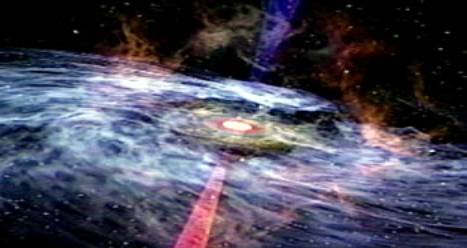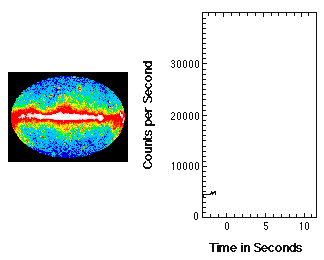
| 2008-10-31 07:44:52 |
FEATURE Gamma-ray Bursts: The Mystery Continues, ESA, Science & technology
October 16, 2008: People of the 'Deep South' love a good story and they're about to get a doozy. It begins next week when researchers from 25 countries converge on Huntsville, Alabama, to share the latest findings on the biggest explosions since the Big Bang itself. The 6th Huntsville Gamma-ray Burst Symposium 2008 convenes Oct. 20th and the talking won't stop for four straight days.
One speaker after another will take the audience on a wild ride from the edge of the observable Universe, where gamma-ray bursts so often occur, to our own back yard in the Milky Way galaxy, where a few supermassive stars may be ticking bombs ready to produce bursts too close for comfort. The underlying causes of gamma-ray bursts, their "twitching corpses," and the oddball galaxies that so often host the explosions--those are just a few of the topics on the agenda.
|
|
| A gamma-ray burst heralds the birth of a black hole--an artist's concept. |
The Symposium kicks off with a lecture for non-specialists, "Black Holes: From Einstein to Gamma Ray Bursts," in which NASA astrophysicist Neil Gehrels describes how every gamma-ray burst may herald the birth of a black hole. Members of the public are invited to attend his talk on Monday, Oct. 20th, 7:30 p.m., at the U.S. Space & Rocket Center's Davidson Center Auditorium in Huntsville.
Gamma-ray bursts were discovered in the 1960s during the Cold War. US satellites keeping an eye out for Soviet nuclear testing detected intense bursts of gamma radiation. The bursts weren't coming from the Soviet Union, however, but from space.
Immediately, astronomers had a century-class mystery on their hands. The explosions seemed to pack more energy than a supernova, and they were totally unpredictable, coming from any and all parts of the sky at random and unexpected times. Furthermore, they were brief, some lasting just a split-second. By the time observers swung their telescopes in the direction of a blast--it was gone! One Sunday morning comic of the 1990s showed a dizzy astronomer grasping his telescope for support while a gamma-ray burst went off overhead.
It was a humorous time. While many researchers were convinced gamma-ray bursts came from deep space, millions to billions of light years away, others contended that the explosions were happening right here in the Solar System. And no one could prove them wrong! Experts were free to entertain the wildest theories their imaginations could concoct.
Astronomers needed more data. The first wave came from an instrument named "BATSE" onboard NASA's Compton Gamma-ray Observatory. In the mid-1990s BATSE recorded thousands of bursts and mapped their distribution on the sky. The explosions were not confined to the plane of the Solar System; neither were they bounded by the plane of the Milky Way galaxy. Whatever they were, gamma-ray bursts were not local.
| Below: The Compton Gamma-ray Observatory and its BATSE sensors proved that gamma-ray bursts were far outside the Solar System. |
|
|
Meanwhile, NASA and other space agencies were working on a new generation of satellites able to pinpoint the first flash of gamma-rays and transmit coordinates to Earth quickly enough for follow-up observations with ground-based telescopes. This would, astronomers hoped, reveal what kind of galaxies hosted the ferocious explosions (if indeed, the explosions occurred within galaxies) and how far away they were located.
On Feb. 28, 1997, BeppoSAX made a breakthrough. The Dutch-Italian satellite pinpointed a burst and directed astronomers to it in time for them to photograph an optical afterglow. Hubble was brought to bear on the fading explosion and, lo and behold, there was a faint galaxy … far, far away.
Next came NASA's Swift spacecraft, which could not only pinpoint gamma-ray bursts and transmit their coordinates within seconds, but also train its own X-ray, UV and optical detectors on the blasts. Swift was a one-satellite armada of space telescopes! Launched in 2004, Swift has detected hundreds of bursts, monitored their glowing debris at multiple wavelengths, and measured their distances (the current record-holder: 12.8 billion light years, near the edge of the observable Universe). These were the kind of data everyone had been waiting for.
It turns out there are two kinds of gamma-ray bursts, short (< 2 seconds) and long (> 2 seconds).
| An example of a long gamma-ray burst |
|
|
The long ones are widely thought to be "supernovas on steroids," cataclysmic explosions signaling the end of stars 50 to 100 times more massive than the sun. When such a behemoth star explodes, it leaves behind a black hole and beams the news across the cosmos on a wave of gamma rays. The underlying physics was first put forth and developed by University of California physicist Dr. Stan Woosley, and his "collapsar model" is now regarded as the leading explanation for long gamma-ray bursts.
The short ones are more puzzling. They're on-and-off too quickly to be supernovas, and the energies involved don't add up to an exploding star. Many researchers believe they are caused instead by collisions between ultra-dense neutron stars or, maybe, neutron stars colliding with black holes. In either case, the end result is another black hole. The jury is still out, however, and debates at the Symposium are sure to be lively.
There are other mysteries, too. For instance, all types of galaxies contain at least a sprinkling of supermassive stars poised to explode. So, astronomers expect to see gamma-ray bursts coming from spiral galaxies, elliptical galaxies, barred galaxies—the whole gamut. Yet the bursts seem to prefer oddball irregular galaxies over all the others. No one knows why. Another example: The first waves of star formation after the Big Bang should have produced an abundance of supermassive stars primed for gamma-ray bursting. Yet there seems to be a dearth of explosions at redshifts (distances) corresponding to that early epoch. Where are the missing gamma-ray bursts?
NASA's newest observatory, the Fermi Gamma-ray Space Telescope, launched in 2008, is on a mission to answer that question and others like it. Breaking results may be revealed at the Symposium.
Stay tuned to Science@NASA Oct. 20-23 for daily coverage.
The Sixth Huntsville Gamma-Ray Burst Symposium 2008 is sponsored by NASA's Fermi and Swift Projects and hosted by the Fermi GBM Team based at the Marshall Space Flight Center in Huntsville.



